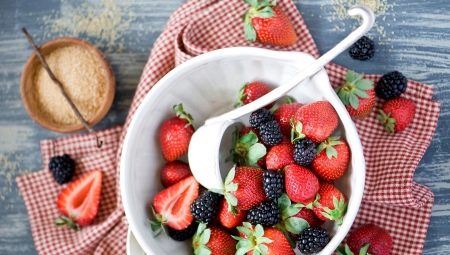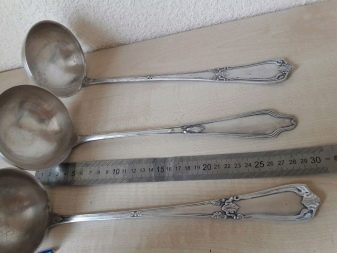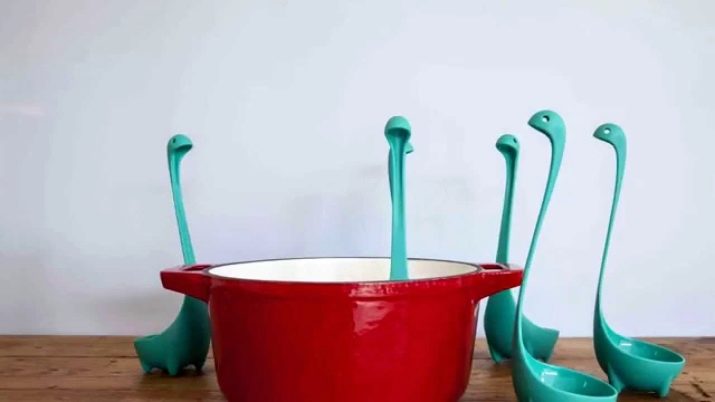Ladle: features and types

A ladle is one of the most commonly used and necessary kitchen utensils and is found in every home. However, despite the seeming simplicity of the design, today there are several varieties of this unpretentious device, and some specimens, in addition to their direct purpose, even act as an important element of kitchen decor.


What is it and what is it for?
A ladle is a large spoon used to pour soup, sauce, gravy and other culinary substances. The scoop volume is usually more than 100 ml, and depends on the purpose of the product. So, models with a capacity of 140-170 ml are usually used for pouring pancake dough into a frying pan, while large stews with a capacity of 200 ml to 1 liter are used as soups. In this regard, most housewives have not one, but two or three ladles of different sizes at once.


Often scoops come in sets with other cutlery and have an ergonomic handle with a hole, hook or ball at the end. Thanks to these accessories, the ladle can be hung on a special "hanger" included in the set, or on a nail.
In many models, the handles have a thickening at the end or grooves. This provides a secure grip and increases the safety of kitchen work.
The handles of the more expensive items are equipped with special silicone or wooden pads that prevent the scoop from heating up while it is in a pot of hot soup. More budgetary options do not have a heat-insulating layer, which makes it necessary to use tacks.


History of appearance
The ladle has been known in Russia since time immemorial, and its first samples were made of wood. The main purpose of the scoops was to remove foam from cooking dishes, however, a little later they began to be used to pour liquid culinary dishes into plates and cups.

Later, metal specimens began to appear, which significantly surpassed wood products in many operational characteristics. Such models were distinguished by high strength and durability, and were not subject to deformation, splitting and swelling, which often happened with wooden ladles. For their manufacture, at first, we used aluminum, and much later, products began to be produced from stainless steel.


In addition to the name "ladle", which has survived unchanged to this day, in different sources you can find other designations for the device, such as the scribe, chumichka and apolonnik. However, the most common synonym for "ladle" is the word "scoop" - short for "chef's spoon".
Today, for the manufacture of ladles, not only wood and metal are used, but also plastic, silicone, and even glass... Scoops are often found in expensive cutlery sets made from precious and semi-precious metals such as gold, silver or cupronickel.


Manufacturing materials
As mentioned above, for the manufacture of ladles, different materials are used, each of which endows the finished product with certain working properties.
Wood
Wood is the oldest type of raw material for ladles, and, despite a number of disadvantages, it continues to be used for the production of ladles.
However, today, wooden scones are more of a decorative function than a practical one, and are often one of the central elements of a rustic interior.
TO material advantages include naturalness and environmental friendliness, as well as aesthetics of appearance and style. The disadvantages include the likelihood of the release of harmful substances from varnished models, which happens when the paint layer interacts with hot liquids. In addition, wooden models, for the sake of decorativeness, are often made quite large and massive, which is why it is not very convenient to use them for their intended purpose.

Metal
Metal ladders are made from copper, aluminum and stainless steel. Such products are distinguished by a long service life, ease of use, ease of maintenance and a laconic appearance. In addition, the metals used for the production of cutlery, when interacting with boiling water, do not emit harmful substances, do not oxidize or rust.
The only drawback of such models is the impossibility of using them for dishes with a non-stick coating, since the delicate surface of the pan or brazier can be scratched from exposure to metal.

Synthetic materials
Synthetic materials in the form of teflon, silicone, nylon, plastic and plastic allow the manufacture of lightweight and comfortable products with different shapes and colors. The models can be used for non-stick interior surfaces - where the use of metal appliances is undesirable. They do not scratch the inner layer of the dishes, are lightweight, can be painted in any colors and have a modern design.
However, some models of plastic ladles emit harmful substances upon contact with boiling water, and therefore are designed exclusively for pouring cold drinks.

Precious metals
Items made of precious metals stand apart. Such models are usually included in expensive dining sets and, in addition to performing their main functions, emphasize the status of the owner and his excellent taste. In addition to making the product highly decorative, the use of precious metals disinfects water, and in some cases enriches it with useful elements.

Varieties
Ladles are classified according to several criteria, such as purpose, scope of use, form and volume. The main criterion of distinction is, of course, the purpose of the device, since it is this that is often decisive for the other two features - configuration and size. According to their functional purpose, there are several types of cooks.
Soup
Soup models, in turn, are subdivided into kitchen and dining rooms. The former are used in food service kitchens, pouring soups and other liquid and semi-liquid culinary dishes into plates. The size of such models often exceeds 300 ml, and the diameter reaches 16 cm or more, which allows you to take portions from the boiler with one scoop. Among kitchen models, there are simply huge specimens that can hold up to 1 liter of liquid.

They are used in public canteens when there is a need to quickly feed a large number of people. Table models are more elegant in size and are used in everyday life. Their volume varies from 200 to 250 ml, which is quite enough for home use. The scoops are often placed on the dining table next to the soup tureens so that each person present can pour their own soup.

For the test
Ladles for dough used in frying pancakes and donuts... Such models have a rather small volume, which usually does not exceed 140-150 ml. Pancake scoops are characterized by wide edges with special grooves on both sides for pouring the dough in a thin stream. The models have a rather narrow specialization, and their use for other needs, for example, for pouring compote or soup, is not very convenient.

For the sauce
Sauce ladles are intended for pouring side dishes and sauces, and do not look like soup models. Their edges are often beautifully grooved, and the work surface ends in a narrow nose. In most cases, the handles of mini sauce ladles also have ornate shapes and are often carved. Sauce ladles are often placed on a beautiful stand, and their volume usually does not exceed 140 ml.
However, ladles are used not only for liquid dishes: there are special models for a cauldron, with which it is very convenient to put pilaf and other solid or semi-liquid food.

Popular models
The modern market for cutlery and kitchen utensils presents a large selection of ladles from various companies. Below are a number of models that, according to online stores, are the most popular and occupy the first lines of popularity ratings.
- Ladle Ototo Nessie is a blue nylon product and is available in sizes 24.5x8x8 cm. The model has an unusual appearance and is made in the shape of a Loch Ness monster. There are legs on the lower part of the working bowl that allow you to store the product in an upright position. Such a scoop is produced in China, and costs 480 rubles.

- Ladle Tupperware is produced in strict black and red colors and can pretend to be a worthy decoration of any modern interior. The width of the working bowl is 9.5 cm, the length of the handle is 28 cm. The material used is polyamide, which can easily withstand temperatures up to 150 degrees. At the same time, the product does not deform, does not emit toxic substances into the environment, and, due to its low thermal conductivity, does not heat up even after a long stay in a saucepan with hot soup. Such a ladle costs 499 rubles.

- Model Gipfel 6479 Tramonto made of environmentally friendly material - nylon, and weighs only 100 g. The product can be placed in the dishwasher, is available in different colors and measures 10x34 cm. The handle of the scoop is made of rubberized plastic, which prevents it from heating up from hot liquids. Such a ladle costs 310 rubles.

- Ladle Pitagora the Italian company Pintinox has a working bowl 10 cm wide and 3 mm thick, and a handle 18 cm long. The model is made of high quality stainless steel and has a discreet design and classic shapes.The cost of the scoop is 844 rubles.

- Ladle Gipfel Comfort 6455 made in black and purple tones and made of nylon. The handle has a hole for hanging, the dimensions of the product are 27.4x9.2 cm, weight - 134 g. Such a scoop is produced in Germany, and its cost is 395 rubles.

In the next video, you can familiarize yourself with a special model of a ladle designed for a cauldron.








